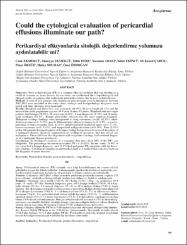Could the cytological evaluation of pericardial effusions illuminate our path?

View/
Date
2018Author
Ekmekçi, CenkEkmekçi, Sümeyye
Dere, Yelda
Adalı, Yasemen
Ekinci, Selim
Çabuk, Ali Kemal
Özdoğan, Ömer
Metadata
Show full item recordAbstract
Objective: Pericardial effusion (PE) is a common clinical condition that can develop as a result of systemic or heart disease. In our study, we synthesized the cytopathological and clinical results of patients who underwent pericardiocentesis due to pericardial effusion. Method: A total of 213 patients who underwent percutaneous pericardiocentesis between 2007-2017 were included in the study: their cytologic and histopathologic diagnoses were noted and their relations were examined. Results: Hundred and thirty-two cases were male (61.9%), 81 were female (38.1%) and the mean of the study population age was 59.9 (min 13-max 97) years. Hundred and sixty-eight patients had benign (78.9%), 10 suspicious (4.6%), 3 non-diagnostic (1.4%) and 32 malignant cytologies (15.1%). Benign pericardial effusion was the most common diagnosis. Malignant cytology findings were interpreted as lung carcinoma (n=20: 62.5%), rhabdomyosarcoma (n=1: 3.1%), poorly differentiated adenocarcinoma (n=2: 6.2%), a gastrointestinal system carcinoma (n=4: 12.5%), undifferentiated epithelial tumor (n=1: 3.1%), breast carcinoma (n=1: 3.1%), and unspecified malignant tumor (n=3: 9%). Four (2.4%) of the 168 patients having diagnosis of benign cytology had previously received diagnosis of a malignant disease, however examination of cytological specimen. Did not reveal any malignancy. Three (30%) of the 10 patients with suspicious cytology, had received diagnosis of a malignant disease previously. Conclusion: In developed countries, it is reported that more than 50% of the PE’s are idiopathic. The percentage of cancer-associated PE’s is 10-25%. In our study, 78.9% of our cases had a benign diagnosis, and 15.1% had malignant PE consistent with the literature findings. Cytological sampling in pericardial fluid is a method that can shed light on the diagnosis of many diseases. Amaç: Perikardiyal efüzyon (PE) sistemik veya kalp hastalıklarının bir sonucu olarak gelişebilen yaygın bir klinik tablodur. Çalışmamızda, perikardiyal efüzyon nedeniyle perikardiyosentez uygulanan hastaların sitopatolojik ve klinik sonuçlarını sentezledik. Yöntem: Çalışmaya 2007-2017 yılları arasında perkütan perikardiyosentez yapılan 213 hasta alınmış, sitolojik ve histopatolojik tanıları not edilmiş ve ilişkileri irdelenmiştir. Bulgular: Olguların 132’si erkek (%61,9), 81’i kadın (%38,1) olup, yaş ortalaması 59,9 (min. 13 - maks. 97)’dur. Sitolojik bulgulara göre; 168’i benign sitoloji (%78,9), 10’u kuşkulu sitoloji (%4,6), 3’ü tanısal olmayan (%1,4) ve 32’si malign sitoloji (%15,1) tanısı almıştır. En sık benign perikardiyal efüzyon tanısı mevcuttur.Malign sitoloji tanılı olguların 20’si akciğer karsinomu (%62,5), 1’i rabdomyosarkom (%3,1), 2’si az diferansiye adenokarsinom (%6,2), 4’ü gastrointestinal sistem ilişkili karsinom (%12,5), 1’i indifferansiye epitelyal tümör (%3,1), 1’i meme karsinomu (%3,1), 3’ü tiplendirme yapılamayan malign tümör (%9) olarak yorumlanmıştır. Benign sitoloji tanılı 168 hastanın 4 (%2,4)’ünün malignite tanısı var olmakla birlikte, sitolojik örneğe yansıyan malignite bulgusu yoktur. Kuşkulu sitoloji olarak tanı almış 10 olgunun 3’ünün (%30) malignite tanısı mevcuttur. Sonuç: Gelişmiş ülkelerde PE’lerin %50’sinden fazlasının idiyopatik olduğu bildirilmektedir. Kanser ilişkili PE’lerin oranı %10-25’tir. Çalışmamızda, literatürle uyumlu olarak %78,9 olgu benign, %15,1 olgu malign PE’dir. Perikardiyal sıvılarda sitolojik örnekleme birçok hastalığın tanısına ışık tutabilen bir inceleme yöntemidir.
Source
İzmir Tepecik Eğitim Hastanesi DergisiVolume
28Issue
2URI
https://doi.org/10.5222/terh.2018.099https://app.trdizin.gov.tr//makale/TXpFNU5qVXhNUT09
https://hdl.handle.net/20.500.12809/8370

















